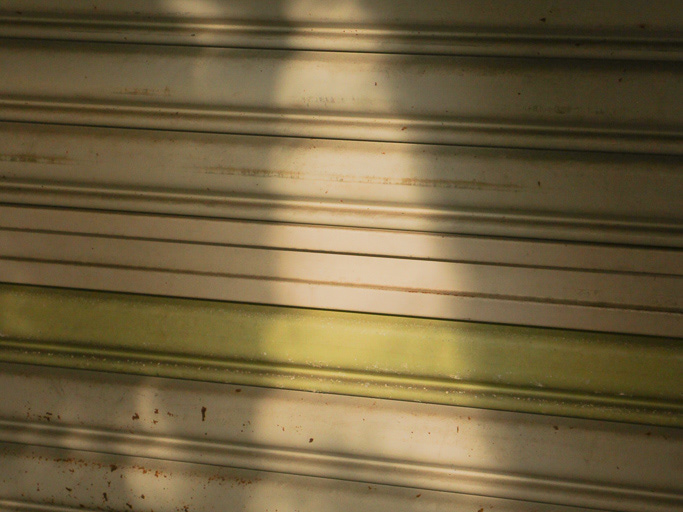"For the great plateful of blue water was before her; the hoary Lighthouse, distant, austere, in the midst; and on the right,
as far as the eye could see, fading and falling, in soft low pleats, the green sand dunes with the wild flowing grasses on them, which always seemed to be running away into some moon country, uninhabited of men."
as far as the eye could see, fading and falling, in soft low pleats, the green sand dunes with the wild flowing grasses on them, which always seemed to be running away into some moon country, uninhabited of men."
In planning her three-part novel To the Lighthouse, Virginia Woolf described the novel's structure with an image of two blocks joined by a corridor. Courtesy of Woolf Online.
"What is the meaning of life? That was all--a simple question; one that tended to close in on one with years. The great revelation had never come. The great revelation perhaps never did come. Instead there were little daily miracles, illuminations, matches struck unexpectedly in the dark; here was one. This, that, and the other; herself and Charles Tansley and the breaking wave; Mrs. Ramsay bringing them together; Mrs. Ramsay saying, "Life stand still here"; Mrs. Ramsay making of the moment something permanent (as in another sphere Lily herself tried to make of the moment something permanent)--this was of the nature
of a revelation. In the midst of chaos there was shape; this eternal passing and flowing (she looked at the clouds going and the leaves shaking) was struck into stability. Life stand still here, Mrs. Ramsay said. "Mrs. Ramsay! Mrs. Ramsay!" she repeated. She owed it all to her."
of a revelation. In the midst of chaos there was shape; this eternal passing and flowing (she looked at the clouds going and the leaves shaking) was struck into stability. Life stand still here, Mrs. Ramsay said. "Mrs. Ramsay! Mrs. Ramsay!" she repeated. She owed it all to her."
* * *
Virginia Woolf breathes rich swells of life into her characters, none more carefully inflated with inner complexity than the matriarchal Mrs. Ramsay in To The Lighthouse. Mrs. Ramsay is subservient yet commandeering, loving but indifferent: these contradictory shades are essential to her full self. Indeed, Mrs. Ramsay is the stable nexus from which all life’s action flows––she looms over her domestic kingdom with a gaze that both observes and prescribes meaning to every social interaction. This beautiful, ebullient wholeness of existence, however, is but briefly teased. As she transitions abruptly from ‘The Window’ into the impersonal liminality of ‘Time Passes’, the laconic death of Mrs. Ramsay destroys the vital significance Woolf constructed, only emptiness left in its wake. It is through this jarringly cruel collapse of life’s fullness that Woolf nuances what we understand of life. Though Woolf’s narration creates a rupture in life’s wholeness she can only imperfectly restore, the vacancy––both an imprint of vitality lost and a space of potentiality––that persists is crucial to truthfully capture life’s meaning. Life as Woolf presents it is neither wholly nihilistic nor hopeful, unsatisfying yet wonderful in its moderated beauty.
From the outset, Woolf immediately presents Mrs. Ramsay as a generative force of life and wonder, her loveliness a vital force that invigorates those around her. Her first word is an emphatic, affirmative “Yes”, Mrs. Ramsay directly associated with a positive constructiveness as she continues “of course, if it’s fine tomorrow,”. Even with simple, insubstantial words, she creates a tangible exuberance in James, as “To her son these words conveyed an extraordinary joy, as if it were settled, the expedition were bound to take place, and the wonder to which he had looked forward, for years and years it seemed, was, after a night’s darkness and a day’s sail, within touch.”. By introducing James as Mrs. Ramsay’s son, Woolf ties her to an image of maternal creation and a pregnant fullness, who not only nurtured and gave life to her child but his imaginative, extraordinary joy. The bare economy of Mrs. Ramsay’s words is placed in striking contrast to the breathless run-on sentence that follows, its length punctuated with multiple commas in reflection of her additive ability to continually create life. In an instant, she collapses the spatial-temporal gulf of “years”, while “a night’s darkness and a day’s sail”, though encompassing an entire day, becomes hopefully accessible to the little boy. Later on, Woolf emphasises Mrs. Ramsay’s life-imbuing, restorative power as she responds to Charles Tansley’s desire for sympathy. Mrs. Ramsay “seemed … at once to pour erect into the air a rain of energy, a column of spry, looking at the same time animated and alive as if all her energies were being fused into force, burning and illuminating (quietly though she sat, taking up her stocking again)”. Woolf’s verb choices characterise Mrs. Ramsay as a potent force of flowing, generative sublimity. She suffuses everything in intense, effervescent beauty, the image of rain reflective of her pervasive influence, as vitality is diffused and permeates the atmosphere. The sheer density of literary devices in this sentence reflects the overwhelming force of her power, and Mrs. Ramsay becomes a life-giving whole from whom energy radiates, this liveliness made all the more extraordinary by the remark Woolf casually slips in brackets. The transcendence Woolf has just described contrasts the inoffensive domesticity of the actual scene, Mrs. Ramsay’s influence commanding but subtly imperceptible. That Woolf prefaces all lofty metaphor with verbs linked to incorporeal appearance only heightens the vibrancy of life that Mrs. Ramsay effuses. Her generative potential creates energy from insubstantiality, transforming life into something remarkable in the simple wonder to be found even in its most understated moments. Woolf offers the satisfying, culminating effects of Mrs. Ramsay’s power––Tansley, “Filled with her words, like a child who drops off satisfied” is “restored, renewed”. The metaphor of a suckling child reveals Tansley as substantially nourished and made whole by Mrs. Ramsay’s efforts, the alliteration of liquid consonants echoing the flowing, dynamic rejuvenation he has experienced. Mrs. Ramsay too is in a state of sensual resplendence. Though spent, it is an “exquisite abandonment to exhaustion” that necessarily follows from apotheotic creation, Mrs. Ramsay revelling in “the rapture” of life “expanded to its full width”, life as she creates and experiences it a revelatory whole.
Mrs. Ramsay is not simply characterised by her generative power either—Woolf’s free indirect speech draws readers into the intricacies of Mrs. Ramsay’s mind, making her intimately and viscerally real. The domestic banality of a mother trying to get her toddler to stop fidgeting is transformed into a contemplative, meaningful moment as we are plunged into the vast mental space of Mrs. Ramsay’s thoughts, traversing over three hundred miles to London then Scotland and Switzerland. Still, that Woolf bookends this stream of consciousness with a repetitive insistence on reality as Mrs. Ramsay instructs James to “stand still” makes us aware that these complexities are all cerebral, her thoughts racing through multiple ideas in a single instant emphasising the depth of her character. Indeed, as Woolf closes the first part of her novel, Mrs. Ramsay seems to be at the height of a life richly textured with emotionality. The intimate moment shared with her husband is interspersed with the simple, lovely acknowledgement of “how beautiful it often is––the sea at night”. Blissful beauty culminates in the wordless, inarticulable pure love they share, Woolf shifting seamlessly between what “He wanted” and what “she knew” to intertwine their thoughts into a harmonious, triumphant unity.
This fictional fullness of life, however, is swiftly collapsed by Woolf in ‘Time Passes’. Woolf disappears into cold impersonality, the narrative indifference trivialising the tragedy of Mrs. Ramsay’s death while depriving us of any catharsis or solace in its wake. Though Chapter 1 begins with an expected, realistic domesticity, successive shifts in tone sink us into a suffocating darkness that marrs the inoffensive scene Woolf opens with. She declares impassively its emergence with an unembellished “So”, describing it as a certain fact: “So with the lamps all put out, the moon sunk, and a thin rain drumming on the roof a downpouring of immense darkness began. Nothing, it seemed, could survive the flood”, which “swallowed up here a jug and basin, there a bowl of red and yellow dahlias, there the sharp edges and firm bulk of a chest of drawers”. Though darkness is immediately metaphorised as an enveloping torrent of water akin to the apocalyptic Biblical flood, it remains tethered to apparently familiar scenes of night—the lights turned off in a home, the natural image of a moon sinking behind clouds. Woolf initially straddles this realistic familiarity and a strange, dark expanse; the darkness completely engulfs quotidian household objects but is tempered by the expository note Woolf addends that brings us back to a comprehensible place and time: “[Here Mr. Carmichael, who was reading Virgil, blew out his candle. It was past midnight.]”. This tether to reality is only transitory, however, and Woolf’s abstract impersonality soon transforms domesticity into pervasive, threatening, endless darkness. Following the disorientating shifts between realism and abstraction, the disinterested narration rips away reality entirely, Woolf dismissive as she asks rhetorically, “But what after all is one night? … Night, however, succeeds to night.”. She alienates readers from their uneasy reactions to the trivialised, temporary darkness of the previous chapter, before extending night to an eternal, perpetual space devoid of time-markers that surpasses even the strangeness of what came before. Woolf coldly presents to us a nightmarish scene of unending darkness. Trees “plunge and bend and their leaves fly helter skelter until the lawn is plastered with them and they lie packed in gutters and choke rain pipes and scatter damp paths.”. The frantic repetition of “and” stringing together Woolf’s dynamic verb choices, coupled with a distinct lack of punctuation, paint the eternal night as a place of continuous yet dissonant and terrifying chaos. The insertion of the parenthetical at the end of this sequence, then, initially appears (as it was previously) as a welcome return to reality. This is the cruel trick Woolf plays in curtly imparting what follows: “[Mr. Ramsay, stumbling along a passage one dark morning, stretched his arms out, but Mrs. Ramsay having died rather suddenly the night before, his arms, though stretched out, remained empty.]]”. That Mrs. Ramsay’s death is reported in a contingent gerund, the participle form of “having died” necessarily subordinate to and incomplete without Mr. Ramsay’s action, not only trivialises her sudden, laconic death but emphasises instead the utter emptiness of what follows after. It is a disturbingly cruel destruction, enacted so suddenly in the span of a few pages, of the wholesome fullness that preceded ‘The Window’. Indeed, by isolating the event within the rigid, disruptive angularity of the square brackets, Mrs. Ramsay’s death is marked merely as a distinct, peripheral happenstance that closes the chapter. With this abrupt move, Woolf deprives us again of any sympathetic reaction––the stark contrast in tone within and outside the brackets means that we stumble unexpectedly upon her death, left reeling in the slim aftershock with only the devastating hollowness of vacant, unfilled arms. Woolf quickly returns, almost relieved in her matter-of-factness, efficiently shifting back to realism, detailing the objective state of the emptied house after death. In so doing, she emphasises the complete vacancy of life in loss, a complete, brutal deflation of the beauty presented to us before. In fact, the entire first section seems to become inconsequential in wake of ‘Time Passes’, the disillusioning indifference of abstract, elemental forces destroying completely the simple fullness of life Woolf seemed to lovingly create.
It is difficult, given the force of Woolf’s bathos, to see beyond this destruction back into hope. The easy indifference with which Woolf tears down her own construction makes us inherently distrustful of what she creates in the aftermath. It is an uncertain, defensive reader that approaches ‘The Lighthouse’, worsened by Woolf’s animation of bleakness through Lily Briscoe’s mind. The same stream of consciousness used to build up a spirited vitality in Mrs. Ramsay now enacts viscerally the existential hopelessness the reader feels: “What does it mean then, what can it all mean? Lily Briscoe asked herself, wondering whether, since she had been left alone, it behoved her to go to the kitchen to fetch another cup of coffee or wait here.”. Woolf emphasises Lily’s despair, as she repeats hollowly a question that in itself is merely an ambiguous “catchword” bringing her no closer to the truth. That Woolf has Lily slip seamlessly from questioning life’s meaning into the absurd mundanity of procuring coffee highlights life’s banality, the vacancy of grief made clear as Lily “could only make a phrase resound to cover the blankness of her mind until these vapours had shrunk. For really, what did she feel, come back after all these years and Mrs. Ramsay dead? Nothing, nothing––nothing that she could express at all.”. The repetition of “nothing” marks Lily’s mind as a vast, blank absence, all thoughts only insubstantial: Woolf describes the echoey resonance of an already ambiguous question amidst the airy vapours of grief, question marks littered throughout emphasising an unstable belief in life’s significance. Even when she explicitly offers us the creative process of art as a solution to this state, it remains only imperfect and unsatisfactory. Facing the canvas, Lily despairs bitterly that “It was all Mrs. Ramsay’s doing. She was dead. Here was Lily, at forty-four, wasting her time, unable to do a thing, standing there, playing at painting, playing at the one thing one did not play at, and it was all Mrs. Ramsay’s fault. She was dead. The step where she used to sit was empty. She was dead.”. Woolf persists in stressing the petty nature of existence with Lily’s petulant repetition of “it was all Mrs. Ramsay’s…”. Unable to fixate on anything but the bare, starkly presented fact that “She was dead.”, Lily inane and desperate, turns to blaming Mrs. Ramsay for her inability to act. She performs the actions but trivialises painting as illusory and merely superficial, this solution too insufficient in addressing the conspicuous absence of the vital force of a woman who, in life, would sit on the steps.
Despite this apparent bleakness, Woolf brings us to the edge of nihilism and refuses to let us go over. In showing us hopeless dissatisfaction, Woolf acknowledges the real, irreparable loss that mars life’s fullness when one comes to know grief, recognising that life can never really be whole; “The great revelation had never come. The great revelation perhaps never did come.”. Yet, Woolf, through Lily Briscoe’s musing on her work, seems to posit that the attempt to live a full life is enough, the vacancy of life lost crucial to the endeavour. Lily realises that she already had a revelation, her little miracle, in the memory of Mrs. Ramsay’s beautiful life, the emptiness a poignant imprint of what loveliness lay in the before. Woolf directly attributes Lily’s brief vision of clarity––that enables her to finish her painting––to her glimpse of the empty steps where Mrs. Ramsay once sat, vacancy not simply essential but also generative, a hollow of memory that shapes our future. Even in death, Mrs. Ramsay nourishes a creativity impossible without her absence, Lily’s final act too one of fulfilment that leaves her, as she “lay[s] down her brush in extreme fatigue”, exquisitely exhausted in a moment of perfect creation, Woolf’s last, eloquent argument for a life that is in its imperfection one worth living.




